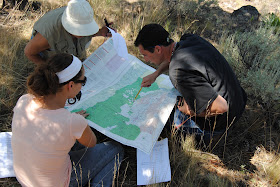Topic Two: Moving Through the Backcountry. This post deals with the considerations a hiker should take while navigating and moving through the wilderness.
Before leaving for a backcountry trip, there are three important steps to accomplish before leaving home. First, tell someone where you are going and when to expect your return. Second, leave a map of your planned route with that responsible person and in your vehicle. Third, fill out the trip plan I have posted on my web site at www.outdoorquest.biz/Links.htm; the trip plan stays with the responsible person. As a Search and Rescue volunteer I have learned that these key steps can make a huge difference in you having to spend an unplanned night in the woods and being found----especially if you incur an unexpected injury or loss of communication.
The following are suggestions to consider before and during a trip into the backcountry.
While compass accuracy is important, many underestimate the topographic map as a key component in backcountry navigation. I recommend carrying a set of maps that include a 7.5’ United States Geological Survey (USGS) map and a map like a United States Forest Survey map. The USGS map gives me the detail information of the immediate area while the other map covers a much broader area. I look for significant land features that will surround my direction of travel. Features such as distinct mountain peaks, a stream, and a ridge line are just of few topographic “hand rails” that can help. For example, if a large stream is to be on your right and it’s not there, it is time to double check your navigation picture.
Figure 1
Additionally, every hiker must account for declination before leaving the trailhead. I like to keep my navigation simple and personally use a compass that can be adjusted for declination such as the Brunton 8010G. This way I don’t have to worry about the math (do I add easterly declination or subtract it?) Declination information found at the bottom of a topographic map is frequently out of date. Check the web site www.magnetic-declination.com to obtain the declination for the location you will be visiting. For more detailed information on declination visit www.outdoorquest.biz/PostsonLandNavigation.htm.
To read the rest of the post go here.


No comments:
Post a Comment